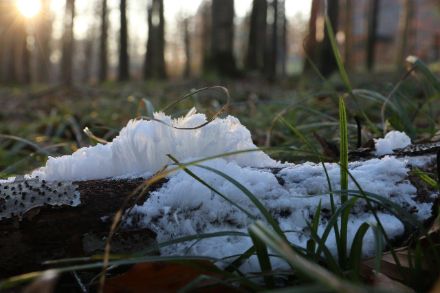Service Navigation
Search
The ideal conditions for hair ice
Hair ice is always an impressive sight to come across in a forest in winter. What is equally astonishing is that many forest visitors overlook the phenomenon and walk straight past it. That is a great pity.
It is worth going out of your way to look for hair ice when the conditions are right. After a few attempts, you have a good chance of success. But what are the ideal conditions?

Forest condition

Firstly, you will need to find a suitable patch of woodland. Selecting this is really quite simple: the forest must be deciduous or mixed. Ideally, the forest should not be too “tidy”, and there should be plenty of dead wood on the ground (branches and twigs with a diameter ranging from very small to about 10 centimetres). There should also be no snow, or at least very little, on the forest floor.
One important prerequisite for the formation of hair ice is the presence of sufficient moisture in the dead wood, so you should look for damp spots in the forest.
Once you have identified an ideal patch of forest, you just have to wait for the right weather conditions.
Meteorological conditions

The first condition that is conducive to hair-ice formation is rainfall on the few days prior to the formation. If this is followed by a clear and cold night with temperatures of -1 to -5 degrees, finding hair ice is a possibility.
Temperatures should not get too cold, as the water in the dead wood must not freeze completely. It is also ideal if there is just a slight breeze and the air is not too dry. Otherwise the hair ice will sublimate, i.e. change directly from a solid to a gaseous state.
If all the conditions are present, it is worth making the effort to be in the forest at sunrise. The first rays of sunlight show off the hair ice beautifully, but the filigree hairs melt away quickly in direct sun.
Why does hair ice form?
Now to the difficult question of why hair ice forms in the first place.
Alfred Wegner was the first to describe the formation of hair ice back in 1918. It is now known that the phenomenon only develops on dead wood in which a certain winter fungus (Exidiopsis effusa) is living. Why this happens is not yet know for sure.
What we do know, however, is that liquid water in the wood pores has a lower surface tension and a lower melting point than free water. If the supercooled water from the wood freezes on the surface, more water is sucked out of the wood and the filigree hair grows in length.
A more detailed explanation by Christian Mätzler, hair ice researcher (Interview in german from page 5).
Time-lapse of hair ice growing (Source: Erich Albisser)